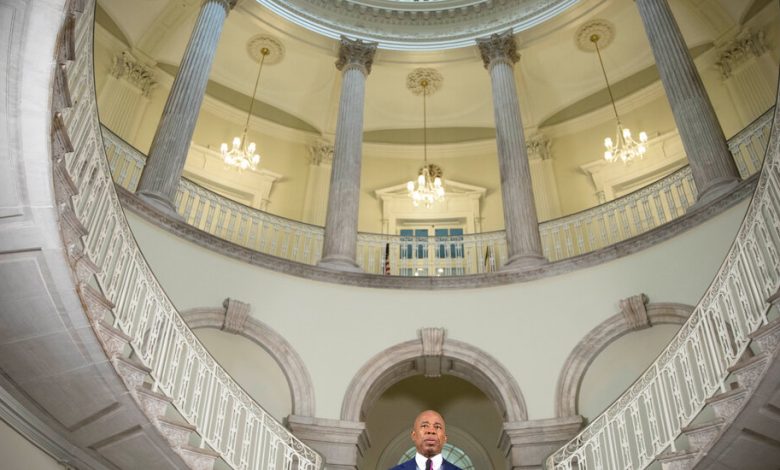State of the City: What Goals Should the Mayor Set for 2023?

Good morning. It’s Thursday. Mayor Eric Adams is scheduled to deliver his State of the City address today. We’ll hear what several sharp-eared experts will be listening for.

Credit…Dave Sanders for The New York Times
In his State of the City address last year, Mayor Eric Adams called for “a new, hopeful chapter.” He said he could spark the city’s comeback from the pandemic with relentless attention to public safety and inequality.
Adams has continued to concentrate on crime, as well as the challenges of accommodating migrants from the southern border and the cleanliness of streets, with a strikingly personal emphasis on ridding them of rats. Today he is expected to announce that the city will expand composting, a program the city put on hold just last month.
But as he outlines his vision for 2023, some measures of the city’s health remain troubling and probably beyond any mayor’s control. The city’s seasonally adjusted unemployment rate was 6.5 percent when he delivered his first State of the City speech. It was 5.9 percent in December, up 0.1 percentage point from November and well above the national rate of 3.9 percent.
With all that in mind, I asked several experienced listeners to tell us what they will be listening for in Adams’s speech. Here’s what they said:
Emma G. Fitzsimmons, City Hall bureau chief, The New York Times
Adams often talks about how he’s focused on the concerns of the Black and Latino voters outside Manhattan who elected him, and that’s the audience for the speech. He told me in an interview recently: “My secret sauce is everyday working-class families.” And he’s giving the speech at Queens Theater in Flushing Meadows Corona Park, not far from where he grew up in Jamaica, Queens, as the son of a house cleaner.
Last year, his first year in office, was defined by crisis — the continuing pandemic, concerns over crime, an influx of migrants arriving from the southern border. Now, going into his second year, a major question is: What is he hoping to accomplish that will be his legacy? And can he pull it off?
Adams doesn’t have one signature policy accomplishment, the way Bill de Blasio had with universal prekindergarten, and Adams isn’t looking for just one. He has said he wants to concentrate on several policies that could help working-class New Yorkers — tax credits for the poor, dyslexia screenings in schools and an expansion of low-cost child care.
Nearly three years into the pandemic, I’m sure he’ll also focus on economic recovery. Advocates are hoping to hear more about his plans to address the city’s affordability crisis, homelessness and violence at the Rikers Island jail complex.
Christopher Herrmann, associate professor, John Jay College of Criminal Justice
Last year was a difficult year for those of us who are really concerned about crime in New York. While we celebrated the significant decreases in shootings and homicides, all the other major crimes increased in 2022 and were much higher than their prepandemic levels.
While the property crimes of auto theft, larceny, and burglary are trending in the wrong direction, I would still like to hear that Mayor Adams and Police Commissioner Sewell remain focused on the violent crimes — murder, rape, robbery, assault, and shootings. These are the things that New Yorkers (and those who commute into New York City for work, school or entertainment) are most interested in.
People want to feel safer going to and from home, work and school. This means feeling safer on the streets, on the subways and the buses, and in their homes.
The perceptions are not in step with the reality. You have a better chance of winning the lottery than you do of getting victimized on the New York City subway, but a lot of people are fearful of the subway, for some reason.
Andrew Rein, president, Citizens Budget Commission
Of course he will reflect on where the city is now, which is certainly a challenging time economically. On the fiscal side, there is money in the city coffers for the short term, but the economic and fiscal headwinds are not only large but they’re also very clear. He has a budget that has baked-in fiscal cliffs because we have ongoing programs that are funded with federal Covid aid as well as city money that is just put in for one year at a time. The future budget gaps that you can see and the fiscal risks that are not even on the paper are large, so he’s got to start now addressing those.
Which leads to the next part. He has announced many plans and blueprints for housing, for economic development, for the ferries. Many plans. Year 2 should be about organizing and managing to get those done. With the lessons from Year 1, how will he hone his management structure so all these plans actually deliver results? That’s the task for Year 2. I hope he does it all great.
Msgr. Kevin Sullivan, executive director of Catholic Charities of the Archdiocese of New York
I hope he would reiterate that New York is welcoming city for migrants. In this new surge since last summer, New York has maintained the tradition of being welcoming. We’re going to continue to do this as a city. But at the same time, he should continue to call for response by the federal government, because that’s what’s needed — and do it in a variety of ways to make the case that it’s a national responsibility. Going to the border was a way to do it. But we need to look at this as a national problem. We need congressional action.
David Giffen, executive director, Coalition for the Homeless
We know the mayor has his hands full with the influx of asylum seekers, and we agree that the federal government has to step up and help New York City.
But that does not relieve the mayor of his moral and legal obligation to provide decent and accessible shelter for all who need it. We need vastly more beds in shelters designed for unsheltered homeless people who have had bad experiences in the congregate shelter system. And the city could move current shelter residents more quickly into permanent housing, freeing up capacity in the shelter system.
The mayor also has to completely rethink his approach to unsheltered people in the streets and the transit system.
Rachel Fee, executive director, New York Housing Conference
We’ll be looking to see if the mayor is really taking seriously the staffing vacancy issue and if he has a real plan to hire for the many vacant positions that are affecting implementation of his housing plan. There are several hundred open positions at the Department of Housing Preservation and Development and the Human Resources Administration. Across those agencies, it’s a really major issue. Just for H.P.D., October was the first time we saw in nine months that the agency was gaining more staff than it was losing, but only a 1 percent increase. The city has been slow to turn around the staffing shortage. We would like to see policies to turn that around more quickly.
Tom Wright, president, Regional Plan Association
I think the most important thing is going to be following up on the “City of Yes” initiatives from the Department of City Planning and the “New” New York Panel recommendations. There was an enormous amount of overlap between the two. I was on the “New” New York Panel, which was a joint effort created by the mayor and Gov. Kathy Hochul.
She has proposed amending state law to allow the city to rezone neighborhoods and create more residential development, including more affordable housing. It’s important that Mayor Adams advocate for these changes and explain how they will help New York City recover from Covid.
Weather
Expect a chance of rain, with wind gusts and temperatures around the mid-40s. The evening is breezy and partly cloudy. Temps will drop to around 30.
ALTERNATE-SIDE PARKING
In effect until Feb. 13 (Lincoln’s Birthday).
The latest New York news
-
Baruch volleyball team: The Baruch Bearcats played their home opener under a new spotlight after Representative George Santos’s lie about having played for the team resurfaced.
-
Campaign loans: An updated campaign finance report raised new questions about the source of Santos’s six-figure loans to his campaign.
-
Bike-path terror trial: In closing arguments, the two sides dueled over why Sayfullo Saipov drove a truck onto a Manhattan bike path in 2017, killing eight people.
METROPOLITAN diary
Knee deep
Dear Diary:
I was walking down Seventh Avenue in the West Village with a friend after a heavy snowfall. We stepped off a curb and sank knee deep in icy slush.
We were fuming because we hadn’t been able tell how deep the puddle was. Just then we heard laughter a few feet away, obviously at our expense.
I was annoyed, but my friend stopped to speak to the people who were laughing. He waved me over, and they explained that they had stepped into the puddle too.
We continued talking. As we stood there, several other people stepped off the curb, sank into the puddle, got annoyed and then, like us, started to laugh.
— Peter Jameson
Illustrated by Agnes Lee. Send submissions here and read more Metropolitan Diary here.
Glad we could get together here. See you tomorrow. — J.B.
P.S. Here’s today’s Mini Crossword and Spelling Bee. You can find all our puzzles here.
Melissa Guerrero and Ed Shanahan contributed to New York Today. You can reach the team at [email protected].
.




